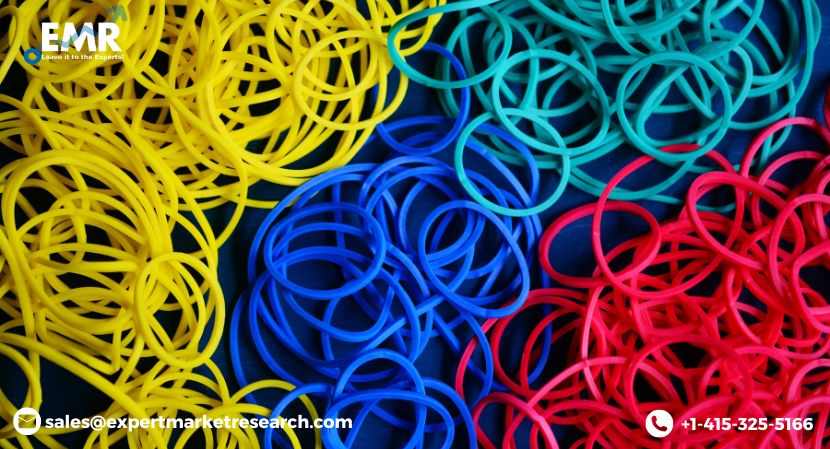The global rubber market share is anticipated to grow at a compound annual growth rate (CAGR) of 5.0% between 2024 and 2032. Rubber, a versatile material, is widely used across various industries, including aerospace, medical, defense, automotive, printing, and agriculture, making it a critical commodity for industrial applications. With significant demand coming from North America, Europe, and Asia, the market is poised for growth, driven by advancements in technology, increasing industrialization, and the rising need for sustainable solutions.
Key players in the global rubber market include Arlanxeo, Kumho Petrochemical, TSRC Corporation, LG Chem, Von Bundit Co., Ltd., Sri Trang Agro-Industry Plc., and Southland Holding Company, among others.
Market Outlook (2024-2032)
The global rubber market is set to witness significant growth due to its indispensable applications across various sectors. The rising demand for rubber in the automotive industry for tire production and the increasing use of synthetic rubber in medical and defense applications are key factors driving this growth. Additionally, advancements in rubber recycling technologies and the shift towards more sustainable practices are expected to create new opportunities in the market. The Asia-Pacific region, particularly China and India, is projected to lead in both production and consumption, while North America and Europe continue to be key markets due to their strong industrial base.
Report Overview and Market Size
The global rubber market was valued at a significant figure in 2023 and is expected to grow steadily, reaching a substantial value by 2032. The growing use of rubber in diverse industries, ranging from automotive to aerospace and medical, is contributing to the market’s expansion. Rubber’s unique properties, such as its elasticity, durability, and resistance to heat and chemicals, make it a vital component in various products, including tires, seals, gloves, and medical devices.
In 2023, natural and synthetic rubbers were key categories in the market, with synthetic rubber dominating due to its superior performance in high-demand applications. The increasing demand for sustainable and eco-friendly rubber products is also pushing manufacturers to explore alternatives to traditional rubber, including bio-based and recycled rubbers.
Market Dynamics
Key Market Drivers
- Rising Demand in the Automotive Industry: The automotive industry is one of the largest consumers of rubber, particularly for tire manufacturing. As the global automotive market grows, driven by the increasing demand for electric vehicles (EVs) and other vehicles, the need for high-performance rubber products, including tires, seals, and gaskets, is expected to rise.
- Growth in Industrial Applications: Rubber is used extensively in industrial applications, including conveyor belts, seals, hoses, and vibration dampers. The growth of industries such as aerospace, defense, and manufacturing is contributing to the rising demand for rubber in these sectors.
- Medical and Healthcare Demand: The medical industry is increasingly utilizing rubber for various applications, such as gloves, seals, and tubing. The rising demand for medical supplies, particularly post-pandemic, has further boosted the market for rubber in healthcare.
- Technological Advancements: Continuous innovation in synthetic rubber production, including the development of high-performance rubbers with improved durability and resistance, is expected to drive market growth. Additionally, advancements in rubber recycling technology are helping manufacturers meet sustainability goals.
Key Market Challenges
- Volatile Raw Material Prices: The prices of natural rubber can fluctuate due to weather conditions, political instability, and supply-demand imbalances. These price fluctuations pose challenges for manufacturers in maintaining cost stability.
- Environmental Concerns: The rubber industry has faced scrutiny due to its environmental impact, particularly related to deforestation for natural rubber plantations and the disposal of used tires and other rubber products. This has led to increased regulatory pressure and a growing demand for sustainable rubber alternatives.
Segmentation
By Product Type
- Natural Rubber: Derived from the latex of rubber trees, natural rubber is used in products such as tires, gloves, and medical devices.
- Synthetic Rubber: Synthetic rubber, made from petrochemicals, dominates the market due to its superior performance characteristics, especially in applications requiring durability, such as automotive tires and industrial seals.
By Application
- Automotive: The automotive sector is the largest consumer of rubber, accounting for a significant portion of global demand for both natural and synthetic rubbers.
- Industrial: Rubber is used in various industrial applications, including conveyor belts, seals, and hoses, making it essential for manufacturing and other heavy industries.
- Medical: The healthcare industry relies on rubber for gloves, seals, and tubing, particularly in high-demand medical environments.
- Aerospace and Defense: Rubber’s durability and resistance to extreme conditions make it ideal for aerospace and defense applications, including seals, gaskets, and vibration dampening components.
Recent Developments
- Arlanxeo has been focusing on expanding its portfolio of sustainable rubber solutions, including bio-based and recycled rubber materials, to meet the growing demand for environmentally friendly products.
- Kumho Petrochemical has invested in new technologies to enhance the durability and performance of synthetic rubber products, particularly for automotive and industrial applications.
Regional Insights
- North America: North America remains a key market for rubber due to its robust automotive and manufacturing sectors. The region is also witnessing growth in the use of rubber in healthcare and aerospace applications.
- Europe: Europe is a significant consumer of rubber, particularly in the automotive and aerospace sectors. The region’s focus on sustainability and recycling is driving innovation in the rubber industry.
- Asia-Pacific: Asia-Pacific, particularly China and India, is the largest producer and consumer of rubber, driven by the region’s automotive, manufacturing, and healthcare industries. The region is expected to see continued growth due to rapid industrialization and increasing demand for rubber products.
Key Players
- Arlanxeo
- Kumho Petrochemical
- TSRC Corporation
- LG Chem
- Von Bundit Co., Ltd.
- Sri Trang Agro-Industry Plc.
- Southland Holding Company
- Others
Market Trends
- Sustainable Rubber Alternatives: As environmental concerns grow, there is a rising demand for sustainable rubber alternatives, including bio-based and recycled rubber materials. This trend is expected to drive innovation in the market, with companies investing in eco-friendly products.
- Electric Vehicles (EVs): The increasing adoption of electric vehicles is creating new opportunities for the rubber market, particularly for high-performance tires and rubber components that are designed to enhance EV efficiency.
- Rubber Recycling Technologies: Advances in rubber recycling technologies are helping to address the environmental impact of rubber products, particularly in the disposal of used tires. These technologies are expected to play a key role in the future growth of the rubber market.
Application Insights
Rubber is widely used in a variety of industries, including automotive, aerospace, defense, medical, and industrial manufacturing. Its unique properties make it ideal for applications that require flexibility, durability, and resistance to extreme conditions.
FAQs
- What is the projected growth rate of the global rubber market between 2024 and 2032?
The global rubber market is expected to grow at a CAGR of 5.0% during this period. - What are the key drivers of the rubber market?
Key drivers include the rising demand for rubber in the automotive, medical, and industrial sectors, as well as technological advancements in synthetic rubber production. - What are the main challenges facing the rubber market?
Challenges include volatile raw material prices and environmental concerns related to rubber production and disposal. - Which region is expected to lead the global rubber market?
Asia-Pacific is expected to lead the market in both production and consumption, driven by the region’s growing automotive and manufacturing sectors. - What role does the automotive industry play in the rubber market?
The automotive industry is the largest consumer of rubber, particularly for tire manufacturing and other vehicle components. - Are there sustainable alternatives to traditional rubber?
Yes, companies are increasingly developing bio-based and recycled rubber materials to meet the growing demand for sustainable products.



